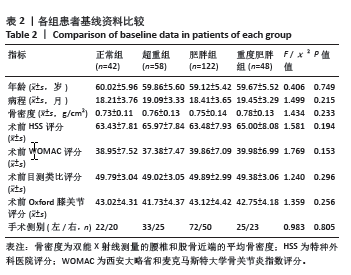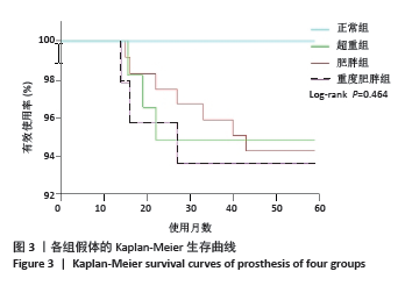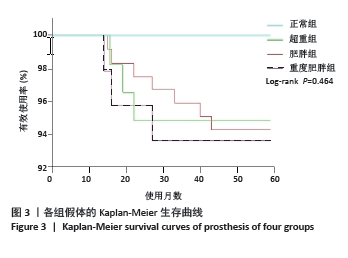Chinese Journal of Tissue Engineering Research ›› 2025, Vol. 29 ›› Issue (21): 4537-4544.doi: 10.12307/2025.186
Previous Articles Next Articles
Correlation between body mass index and efficacy after medial unicompartmental knee arthroplasty in postmenopausal women
Mou Limin1, Li Chao2, Zhang Wenhao1, Shi Zhengyu1, Deng Yingjie1, 3, Fang Rui1, 3
- 1Fourth Clinical Medical College of Xinjiang Medical University, Urumqi 830000, Xinjiang Uygur Autonomous Region, China; 2Sixth Affiliated Hospital of Xinjiang Medical University, Urumqi 830000, Xinjiang Uygur Autonomous Region, China ; 3Affiliated Hospital of Traditional Chinese Medicine of Xinjiang Medical University (Institute of Traditional Chinese Medicine of Xinjiang Uygur Autonomous Region, Xinjiang Uygur Autonomous Region Traditional Chinese Medicine Hospital), Urumqi 830000, Xinjiang Uygur Autonomous Region, China
-
Received:2024-01-25Accepted:2024-04-30Online:2025-07-28Published:2024-12-06 -
Contact:Fang Rui, Chief physician, Professor, Master’s supervisor, Doctoral supervisor, Fourth Clinical Medical College of Xinjiang Medical University, Urumqi 830000, Xinjiang Uygur Autonomous Region, China; Affiliated Hospital of Traditional Chinese Medicine of Xinjiang Medical University (Institute of Traditional Chinese Medicine of Xinjiang Uygur Autonomous Region, Xinjiang Uygur Autonomous Region Traditional Chinese Medicine Hospital), Urumqi 830000, Xinjiang Uygur Autonomous Region, China -
About author:Mou Limin, Doctoral candidate, Fourth Clinical Medical College of Xinjiang Medical University, Urumqi 830000, Xinjiang Uygur Autonomous Region, China -
Supported by:Technology Innovation Leading Talent Project-High Level Leading Talents, No. 2022TSYCLJ0007 (to FR); Key Research & Development Plan Project of Xinjiang Uygur Autonomous Region, No. 2021B03006 (to FR)
CLC Number:
Cite this article
Mou Limin, Li Chao, Zhang Wenhao, Shi Zhengyu, Deng Yingjie, Fang Rui. Correlation between body mass index and efficacy after medial unicompartmental knee arthroplasty in postmenopausal women[J]. Chinese Journal of Tissue Engineering Research, 2025, 29(21): 4537-4544.
share this article
Add to citation manager EndNote|Reference Manager|ProCite|BibTeX|RefWorks
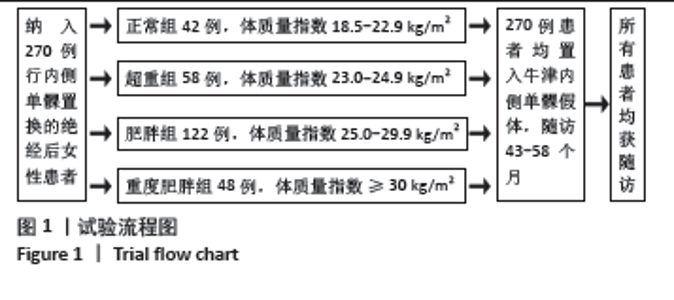
2.1 参与者数量及并发症分析 270例患者按术前体质量指数分成4组:正常组42例、超重组58例、肥胖组122例、重度肥胖组48例均获得术后随访。所有纳入患者均顺利完成手术,术后切口愈合良好,正常组出现2例肌间静脉血栓,肥胖组3例肌间静脉血栓及2例尿潴留,经对症处理后均完全康复出院。术后患者假体生物相容性良好,未出现假体周围感染、过敏反应、及免疫排斥反应等;超重组出现3例患者翻修(创伤衬垫脱位 1例、外侧间室退变1例、无菌性假体松动1例),肥胖组出现7例患者翻修(创伤衬垫脱位 1例、外侧间室退变2例、无菌性假体松动4例),重度肥胖组出现3例患者翻修(创伤衬垫脱位1例、外侧间室退变1例、无菌性假体松动1例)。 2.2 试验流程图 见图1。"
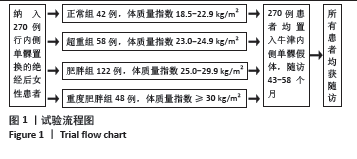
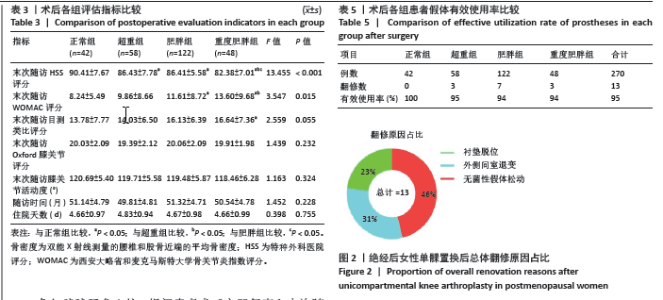
2.4 术后指标比较 如表3所示,各组末次随访HSS评分均较术前有所改善,正常组改善最为显著,重度肥胖组改善效果最差,差异有显著性意义(P < 0.05)。经过两两比较,发现超重组、肥胖组、重度肥胖组与正常组之间差异有显著性意义(P < 0.05)。重度肥胖组与正常组、超重组以及肥胖组之间的差异也有显著性意义(P < 0.05)。由此可见,重度肥胖对术后HSS评分有一定影响,肥胖会影响患者术后的HSS评分。 经比较发现,末次随访4组WOMAC评分均较术前有所降低,患肢功能明显改善,组间差异有显著性意义(P < 0.05)。肥胖组、重度肥胖组与正常组比较,差异有显著性意义(P < 0.05),重度肥胖组与超重组比较差异也有显著性意义(P < 0.05),其余组间比较差异均无显著性意义(P > 0.05)。 除上述两个指标外,其余指标各组间比较差异均无显著性意义(P > 0.05)。"
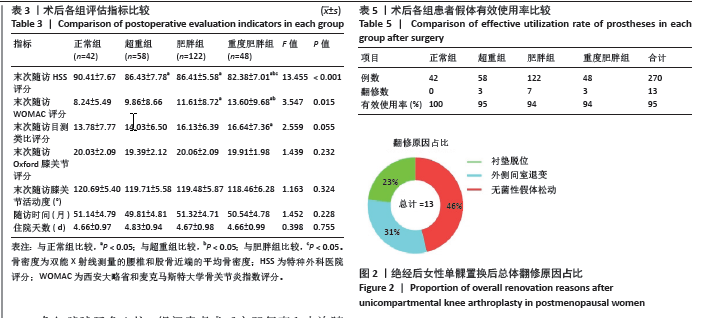

2.5 各组髋膝踝角比较 组间患者术后立即复查和末次随访复查的髋膝踝角值比较结果显示,差异均无显著性意义(P > 0.05)。组内患者术后即刻和末次随访复查的髋膝踝角值比较中发现,除了正常组(P > 0.05)外,其余3组术后即刻和末次随访的髋膝踝角相比差异均有显著性意义(P < 0.05),具体数据见表4。在随访过程中,肥胖和重度肥胖组的髋膝踝角均值均高于正常组。 2.6 随访假体使用情况 通过术后随访研究发现,术后270例患者中13例假体出现翻修情况,其中体质量指数正常组未出现翻修情况,超重组、肥胖组、重度肥胖组分别出现3,7,3例假体翻修患者,见表5。分析各组患者翻修具体原因发现:超重组3例患者中1例创伤衬垫脱位、1例外侧间室退变、1例出现无菌性假体松动;肥胖组7例患者中1例创伤衬垫脱位、2例外侧间室退变、4例出现无菌性假体松动;重度肥胖组3例患者中1例创伤衬垫脱位、1例外侧间室退变、1例出现无菌性假体松动;整体翻修比例中无菌性假体松动占46%、外侧间室退变占31%、创伤衬垫脱位占23%,见图2;上述患者经再次手术治疗,术后恢复良好,无其他并发症发生。"
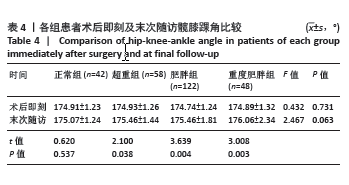
| [1] CHEN H, WU J, WANG Z, et al. Trends and Patterns of Knee Osteoarthritis in China: A Longitudinal Study of 17.7 Million Adults from 2008 to 2017. Int J Environ Res Public Health. 2021;18(16):8864. [2] 樊子娟,王桂杉,李川,等.《中国骨关节炎诊疗指南(2021年版)》解读和评价[J].中国循证医学杂志,2022,22(6):621-627. [3] BICHSEL D, LIECHTI FD, SCHLAPBACH JM, et al. Cross-sectional Analysis of Recommendations for the Treatment of Hip and Knee Osteoarthritis in Clinical Guidelines. Arch Phys Med Rehabil. 2022;103(3):559-569.e5. [4] BELSEY J, YASEN SK, JOBSON S, et al. Return to Physical Activity After High Tibial Osteotomy or Unicompartmental Knee Arthroplasty: A Systematic Review and Pooling Data Analysis. Am J Sports Med. 2021; 49(5):1372-1380. [5] 刘爱峰,崔中赏,余伟杰.胫骨高位截骨与单髁置换的荟萃分析[J].中国矫形外科杂志,2022,30(7):625-629. [6] ABDULLA I, MAHDAVI S, KHONG H, et al. Does body mass index affect the rate of adverse outcomes in total hip and knee arthroplasty? A retrospective review of a total joint replacement database. Can J Surg. 2020;63(2):E142-E149. [7] DIOS K, HUYNH N, TRAN TS, et al. D Association between Fat Mass and Obesity-Related Transcript Polymorphisms and Osteoporosis Phenotypes. J Bone Metab. 2024;31(1):48-55. [8] GKASTARIS K, GOULIS DG, POTOUPNIS M, et al. D Obesity, osteoporosis and bone metabolism. J Musculoskelet Neuronal Interact. 2020;20(3): 372-381. [9] WANG J, SHU B, TANG DZ, et al. D The prevalence of osteoporosis in China, a community based cohort study of osteoporosis. Front Public Health. 2023;11:1084005. [10] JIANG YK, ZHANG QD, HUANG C, et al. [Effect of changes in posterior tibial slope on the mid-term clinical outcomes of Oxford unicompartmental knee arthroplasty]. Zhonghua Yi Xue Za Zhi. 2024; 104(5):344-349. [11] LUO Z, ZENG W, CHEN X, et al. Cocktail of Ropivacaine, Morphine, and Diprospan Reduces Pain and Prolongs Analgesic Effects after Total Knee Arthroplasty: A Prospective Randomized Controlled Trial. Int J Clin Pract. 2024;2024:3697846. [12] 高焕绅,徐熙鹏,孙一,等.体重指数对活动平台单髁置换术中长期临床结果的影响[J].中华骨与关节外科杂志,2021,14(4): 251-527. [13] 唐杞衡,周一新,王兆伦,等.肥胖对膝骨关节炎内侧单髁置换术疗效的影响[J].中国矫形外科杂志, 2022,30(14):1267-1271. [14] AMBROSI TH, SCIALDONE A, GRAJA A, et al. Adipocyte Accumulation in the Bone Marrow during Obesity and Aging Impairs Stem Cell-Based Hematopoietic and Bone Regeneration. Cell Stem Cell. 2017;20(6): 771-784.e6. [15] FISCHER V, HAFFNER-LUNTZER M. Interaction between bone and immune cells: Implications for postmenopausal osteoporosis. Semin Cell Dev Biol. 2022;123:14-21. [16] TAN MWP, NG SWL, CHEN JY, et al. Long-Term Functional Outcomes and Quality of Life at Minimum 10-Year Follow-Up After Fixed-Bearing Unicompartmental Knee Arthroplasty and Total Knee Arthroplasty for Isolated Medial Compartment Osteoarthritis. J Arthroplasty. 2021; 36(4):1269-1276. [17] DEROCHE E, MARTRES S, OLLIVIER M, et al. Excellent outcomes for lateral unicompartmental knee arthroplasty: Multicenter 268-case series at 5 to 23 years’ follow-up. Orthop Traumatol Surg Res. 2020; 106(5):907-913. [18] CALKINS TE, HANNON CP, FILLINGHAM YA, et al. Fixed-Bearing Medial Unicompartmental Knee Arthroplasty in Patients Younger Than 55 Years of Age at 4-19 Years of Follow-Up: A Concise Follow-Up of a Previous Report. J Arthroplasty. 2021;36(3):917-921. [19] MANNAN A, PILLING RWD, MASON K, et al. Excellent survival and outcomes with fixed-bearing medial UKA in young patients (≤ 60 years) at minimum 10-year follow-up. Knee Surg Sports Traumatol Arthrosc. 2020;28(12):3865-3870. [20] KYRIAKIDIS T, ASOPA V, BAUMS M, et al. Unicompartmental knee arthroplasty in patients under the age of 60 years provides excellent clinical outcomes and 10-year implant survival: a systematic review : A study performed by the Early Osteoarthritis group of ESSKA-European Knee Associates section. Knee Surg Sports Traumatol Arthrosc. 2023; 31(3):922-932. [21] HOORNTJE A, PRONK Y, BRINKMAN JM, et al. High tibial osteotomy versus unicompartmental knee arthroplasty for Kellgren-Lawrence grade 3-4 knee osteoarthritis in younger patients: comparable improvements in patient-reported outcomes, adjusted for osteoarthritis grade and sex. Knee Surg Sports Traumatol Arthrosc. 2023;31(11): 4861-4870. [22] KARASAVVIDIS T, FACKLER NP, CALLAN KT, et al.Comparison of Early Complication Rates After High Tibial Osteotomy Versus Unicompartmental Knee Arthroplasty for Knee Osteoarthritis. Orthop J Sports Med. 2024;12(1):23259671231219975. [23] PLANCHER KD, VOIGT C, BERNSTEIN DN, et al. Return to Sport in Middle-aged and Older Athletes After Unicompartmental Knee Arthroplasty at a Mean 10-Year Follow-up: Radiographic and Clinical Outcomes. Am J Sports Med. 2023;51(7):1799-1807. [24] NETTROUR JF, ELLIS RT, HANSEN BJ, et al. High Failure Rates for Unicompartmental Knee Arthroplasty in Trabecular Bone Score and Bone Mineral Density in Postmenopausal Women with Morbid Obesity‑A Clinical Paradox Morbidly Obese Patients: A Two-Year Minimum Follow-Up Study. J Arthroplasty. 2020;35(4):989-996. [25] MUSBAHI O, HAMILTON TW, CRELLIN AJ, et al. The effect of obesity on revision rate in unicompartmental knee arthroplasty: a systematic review and meta-analysis. Knee Surg Sports Traumatol Arthrosc. 2021;29(10):3467-3477. [26] STRECK LE, HANREICH C, CORORATON AD, et al. Predictors for activity following total and unicompartmental knee arthroplasty. Arch Orthop Trauma Surg. 2023;143(11):6815-6820. [27] 牟利民,张文豪,张思平,等.绝经后女性退变性膝骨关节炎疼痛与性激素水平及关节液炎性因子的相关性研究[J].中国全科医学, 2022,25(29):3652-3657. [28] 《中国骨质疏松杂志》骨代谢专家组 张萌萌,马倩倩,毛未贤.骨代谢生化指标临床应用专家共识(2023修订版)[J].中国骨质疏松杂志,2023,29(4):469-476. [29] 何海洋,杨嘉玲,雷迅. 绝经后女性骨质疏松症患病率及影响因素的Meta分析[J]. 中国全科医学,2024,27(11):1370-1379. [30] 蔺海山,米尔阿里木·木尔提扎,李鹏,等.绝经后女性髋部骨折患者骨骼肌肌纤维特点与骨密度的相关性[J].中国组织工程研究, 2021,25(20):3144-3149. [31] RIKKONEN T, SUND R, SIROLA J, et al. Obesity is associated with early hip fracture risk in postmenopausal women: a 25-year follow-up. Osteoporos Int. 2021;32(4):769-777. [32] 张丽,卜淑敏.肥胖对骨骼的双重影响和机制以及在骨疾病中的作用[J]. 中国骨质疏松杂志,2022,28(4):585-589. [33] ZHENG R, BYBERG L, LARSSON SC, et al. Prior loss of body mass index, low body mass index, and central obesity independently contribute to higher rates of fractures in elderly women and men. J Bone Miner Res. 2021;36(7):1288-1299. [34] WATRINET J, BLUM P, MAIER M, et al. Undersizing of the tibial component in Oxford unicompartmental knee arthroplasty (UKA) increases the risk of periprosthetic fractures. Arch Orthop Trauma Surg. 2024;144(3):1353-1359. [35] 高谱, 殷浩, 贺学军. 益生菌通过肠道干预骨质疏松症的研究进展[J]. 中国医师杂志,2023,25(3):468-472. [36] SHIH HT, CHEN KH, LEE CH, et al. Factors predicting lower limb alignment after Oxford medial unicompartmental knee arthroplasty. Sci Rep. 2024;14(1):5597. [37] VAN DER LIST JP, ZUIDERBAAN HA, PEARLE AD. Why Do Medial Unicompartmental Knee Arthroplasties Fail Today? J Arthroplasty. 2016;31(5):1016-1021. [38] BARRETT MC, WILKINSON FO, BLOM AW, et al. Incidence, temporal trends and potential risk factors for aseptic loosening following primary unicompartmental knee arthroplasty: A meta-analysis of 96,294 knees. Knee. 2021;31:28-38. [39] NG HJH, LOKE WJ, JAMES WLH. The Influence of Obesity on Unicompartmental Knee Arthroplasty Outcomes: A Systematic Review And Meta-Analysis. Arch Bone Jt Surg. 2021;9(6):618-632. [40] RICE PE, PATE GA, HILL RD, et al. The association between obesity, knee pain, and gait during stair descent in older adults with knee osteoarthritis. Clin Biomech (Bristol, Avon). 2024;114:106228. [41] VASSO M, CORONA K, GOMBERG B, et al. European Knee Associates Small Implants focus group. Obesity increases the risk of conversion to total knee arthroplasty after unicompartimental knee arthroplasty: a meta-analysis. Knee Surg Sports Traumatol Arthrosc. 2022;30(12): 3945-3957. |
| [1] | Ma Chi, Wang Ning, Chen Yong, Wei Zhihan, Liu Fengji, Piao Chengzhe. Application of 3D-printing patient-specific instruments combined with customized locking plate in opening wedge high tibial osteotomy [J]. Chinese Journal of Tissue Engineering Research, 2025, 29(9): 1863-1869. |
| [2] | Sun Yundi, Cheng Lulu, Wan Haili, Chang Ying, Xiong Wenjuan, Xia Yuan. Effect of neuromuscular exercise for knee osteoarthritis pain and function: a meta-analysis [J]. Chinese Journal of Tissue Engineering Research, 2025, 29(9): 1945-1952. |
| [3] | Wang Peiguang, Zhang Xiaowen, Mai Meisi, Li Luqian, Huang Hao. Generalized equation estimation of the therapeutic effect of floating needle therapy combined with acupoint embedding on different stages of human knee osteoarthritis [J]. Chinese Journal of Tissue Engineering Research, 2025, 29(8): 1565-1571. |
| [4] | He Guanghui, Yuan Jie, Ke Yanqin, Qiu Xiaoting, Zhang Xiaoling. Hemin regulates mitochondrial pathway of oxidative stress in mouse chondrocytes [J]. Chinese Journal of Tissue Engineering Research, 2025, 29(6): 1183-1191. |
| [5] | Ma Haoyu, Qiao Hongchao, Hao Qianqian, Shi Dongbo. Causal effects of different exercise intensities on the risk of osteoarthritis [J]. Chinese Journal of Tissue Engineering Research, 2025, 29(6): 1305-1311. |
| [6] | Wang Dongyang, Yang Qiaohui, Lin Xinchao. Relationship between vitamin D levels and reproductive characteristics and exercise dietary situation in postmenopausal women [J]. Chinese Journal of Tissue Engineering Research, 2025, 29(5): 1021-1025. |
| [7] | Wu Guangtao, Qin Gang, He Kaiyi, Fan Yidong, Li Weicai, Zhu Baogang, Cao Ying . Causal relationship between immune cells and knee osteoarthritis: a two-sample bi-directional Mendelian randomization analysis [J]. Chinese Journal of Tissue Engineering Research, 2025, 29(5): 1081-1090. |
| [8] | Fang Ying, Zhang Yanwei, Li Xi, Yan Peidong, Bi Miao. Improvements in automatic diagnosis methods for knee osteoarthritis based on deep learning [J]. Chinese Journal of Tissue Engineering Research, 2025, 29(35): 7511-7518. |
| [9] | Liu Ning, Sun Yingjin, Huang Long, Feng Shuo, Chen Xiangyang. Optimal rotational alignment of the tibial component during Oxford unicompartmental knee arthroplasty [J]. Chinese Journal of Tissue Engineering Research, 2025, 29(33): 7158-7164. |
| [10] | Liu Xiaowu, Liu Jinping, Wu Ting, He Xian, Cai Jianxiong. Antioxidants from different sources and osteoarthritis: a genome-wide association analysis in European populations [J]. Chinese Journal of Tissue Engineering Research, 2025, 29(32): 7015-7027. |
| [11] | Li Jia, Liu Qianru, Xing Mengnan, Chen Bo, Jiao Wei, Meng Zhaoxiang. A network meta-analysis on therapeutic effect of different types of exercise on knee osteoarthritis patients [J]. Chinese Journal of Tissue Engineering Research, 2025, 29(3): 609-616. |
| [12] | Liu Mengfei, Chen Gang, Shi Yihan, Zeng Lin, Jiang Kan, Yilihamujiang•Wusiman. Finite element analysis of optimization of femoral prosthesis implantation position in unicompartmental knee arthroplasty in osteoporotic patients [J]. Chinese Journal of Tissue Engineering Research, 2025, 29(3): 464-470. |
| [13] | Shi Lei, Shi Song, Lu Yue, Tao Ran, Ma Hongdong. Comparison of unicondylar knee arthroplasty and high tibial osteotomy in treatment of medial knee osteoarthritis [J]. Chinese Journal of Tissue Engineering Research, 2025, 29(3): 503-509. |
| [14] | Yu Bingbing, Wang Tingting, Fang Junlin, Guo Yun, Huang Yingru. Acupuncture for treatment of postmenopausal osteoporosis: meta-analysis, systematic evaluation and trial sequential analysis [J]. Chinese Journal of Tissue Engineering Research, 2025, 29(29): 6305-6316. |
| [15] | Zhang Yunyi, Liu Songtao, Xie Shaodong, Zhu Haifeng, Qian Guifeng, Huo Ming, Zhou Jie, Deng Zixuan. Platelet rich plasma versus hyaluronic acid in treatment of knee osteoarthritis: an overview of systematic reviews [J]. Chinese Journal of Tissue Engineering Research, 2025, 29(28): 6138-6145. |
| Viewed | ||||||
|
Full text |
|
|||||
|
Abstract |
|
|||||

